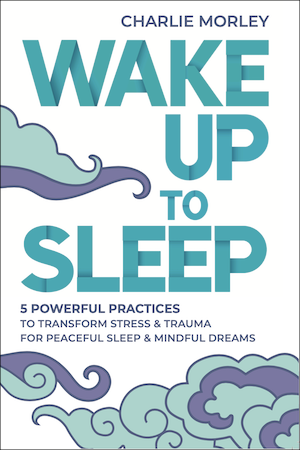The Hypnagogic State: 5 Ways to Find Peace in That Frustrating Getting to Sleep Stage

That period from resting your head on the pillow hoping to transport yourself to tomorrow refreshed, and actually getting into that state of sleep where you don’t have to hope anymore, is an odd one. Sometimes it happens just like that — two minutes and you’re out, waking up to a new you the next day. Other times it’s a bit more frustrating. You’re tossing and turning, eyes closed but consciously going through scenes in your head — money worries, work troubles, that man who accidentally body checked you on the train spilling warm, frothy oat milk latte all over your new winter coat. Just me on that last one?
Anyway, we call this stage 1 sleep — or the hypnagogic state — the transition period between wakefulness and sleep. The latter is a term I’d never heard of until speaking with lucid dreaming specialist Charlie Morley, who has written a book Wake Up to Sleep: 5 Powerful Practices to Transform Stress and Trauma for Peaceful Sleep and Mindful Dreams, that details the process, along with many others related to sleep, and a myriad of well-researched, mindful techniques to help those struggling with restless nights.
A Bit About Charlie…
Morley’s backstory is an intriguing one, and especially relevant to his teachings. In person, he’s humble and refreshingly straight-to-the-point, a likely consequence of having worked extensively with veterans and the armed forces.
He first became interested in lucid dreaming — a type of dream where the dreamer becomes aware that they are dreaming — aged 11. “I’d asked for a NovaDreamer for my birthday,” he tells me. “I had seen it in a gadget magazine. It’s this sleep mask that you strap to your face, and it’s got a little computer and it flashes lights and it’s supposed to give you lucid dreams.”
 From his mid to late teens Morley started reading more deeply into the topic and teaching himself how to do it. “But at that age, I was just using it for having sex, going skateboarding. But mainly sex basically. So I would just get lucid and I’d be like, ‘Pamela Anderson, come to me.'”
From his mid to late teens Morley started reading more deeply into the topic and teaching himself how to do it. “But at that age, I was just using it for having sex, going skateboarding. But mainly sex basically. So I would just get lucid and I’d be like, ‘Pamela Anderson, come to me.'”
After having a near-death experience from an acid overdose aged 17, he began to have recurring PTSD nightmares. These lasted for four months until his growing understanding of lucid dreaming helped him to confront his issues. “In one of those [nightmares], I managed to get lucid and I turned to kind of face it. It was this kind of demon that represented death that always appeared in the dream the same way. And I turned to face him, and the dream changed and the nightmares stopped.”
He started training with Buddhist monks, embedding himself in the spiritual practice and leading his own workshops and retreats. Though the latter, he was approached by Keith Mackenzie, a veteran of the British army’s Parachute Regiment who had become a Buddhist Chaplain and invited Morley to pass on his expertise with lucid dreaming on a mindfulness retreat for veterans. He found instant success with this new audience, especially when it came to connecting his own PTSD with the trauma he was trying to deal with in the veterans.
“Many people are going into the armed forces with pre-existing mental health problems, and they’re going in there searching for a family. The search there is not to learn to kill people or to do harm, it’s to look for a community. Every argument I had in my head for not working with the military just dissolved in that first retreat. The vast majority of veterans I’ve met have been brilliant, loving people who have seen or done stuff that would traumatise anybody, let alone those who might have already had preexisting mental health problems.”
In 2018 his work with veterans and the military led him to secure a Winston Churchill Memorial Trust Fellowship to research best practice in mindfulness-based approaches to PTSD, and among other things, to relay his research in Wake Up To Sleep.
This leads us back to the hypnagogic state, which Charlie outlines five ways to combat in the book. Here we outline those techniques with Morley’s help.
5 Ways To Create Peace In The Hypnagogic State
The Nocturnal Journal
We’re often mindless when it comes to sleep, expecting to just turn off the light and nod off, leading to frustration when it doesn’t quite turn out like that. To start becoming more mindful, it’s worth first acknowledging our sleep and begin to take a good look at it — especially if you’re suffering from nightmares and restless nights.
Starting a nocturnal journal will allow you to create and reinforce the habit of viewing your sleep and dreams as valuable, which according to Morley in Wake Up To Sleep, “creates a bi-directional positive feedback loop in which your conscious mind will become more aware of how you’re sleeping… and your unconscious mind will start to present you with more memorable dreams.”
Take note of the time you went to bed and woke up, and the process of falling asleep, but more importantly any dreams you can remember and the main themes and emotional tone of them, as well as how you felt about them upon awakening.

“A lot of people are under this illusion that some people dream and others don’t,” he says. “But everybody dreams. There’s no way to stop the human brain from dreaming other than a heavy head injury. Dreaming is so linked to your survival — because it’s about re-consolidation of memory and the integration about trauma — that if you weren’t dreaming you would go mad very quickly. Go to sleep with the intention to remember.”
A nocturnal journal is a better method of documenting sleep than a sleep tracker, as it allows you to trust how you feel in the morning, not how your trackers says you should feel.
Hypnagogic Mindfulness
“Being mindful in the process of sleep won’t decrease the level of rest that you get from sleep, it will actually increase it,” says Morley, who recommends hypnagogic mindfulness to get through its namesake state. “Hypnogogic’s really good. You go into deep parasympathetic response, the brain’s really relaxed, goes into alpha and that’s all really good for you. But if you bring consciousness into that, so you intentionally stay in the hypnogogic, then suddenly you get all the benefits of mindfulness, plus all the benefits of stage one sleep.”
If you’re embedded in the world of mindfulness you might have heard of yoga nidra, one of the most popular forms of hypnagogic mindfulness.
As opposed to contorting your body into a one-handed tree pose, yoga nidra starts by resting comfortably in Savasana (back against the mat, arms loose at your side), before a systematic meditation takes you through the Pancha Maya Kosha (five layers of self), leaving you with a sense of wholeness by the end of the class. In sum, it’s a meditation on the moment of falling asleep that can promote deep healing and a very profound state of rest on all levels.
In fact, an eight-week study from John F. Kennedy University, California, on Vietnam veterans found that a course of yoga nidra reduced levels of rage and anxiety, as well as increasing feelings of relaxation and peace.

Coherent Breathing
“Coherent breathing is not actually a form of mindfulness meditation, but it’s a breathing technique that leads to a state of mindfulness,” says Morley. “It’s about slowing the breath rate to such a degree that the electrical impulses of the brain, the lungs, and the heart become synchronised.”
The modern-day human breathes around 15 breaths a minute, but the optimal human breath rate according to Morley is around five. “15 breathes a minute might seem normal, but it is actually so fast that it activates the sympathetic nervous system. This means that right now, simply because of the way you are breathing, your body is in low-level ‘fight or flight’ mode. No wonder so many of us feel anxious all the time.”
Created by Stephen Elliot, a life scientist and author of The New Science of Breath, coherent breathing works to bring your breathing down to that perfect five, and can be practised by simply counting the length of your breaths, or following an audio track to keep to the specific rhythm.
Circle Of Protectors
Inspired and derived from Bon, a pre-Buddhist religious tradition from Tibet which goes back 3,800 years, Circle of Protectors is one of Morley’s favourite techniques when working with groups who are experiencing PTSD trauma nightmares.
“The actual original instruction is very brief. So, if you are fearful upon falling asleep or of nightmares, then imagine you’re falling asleep like a king or queen who is surrounded by protection. And then it says for your protectors you could have gods and goddesses. So that’s the only instruction. From that, I created kind of a bit of a more formalised version basically.”
Morley’s adaptation places these protectors at specific points around your bed, responsible for protecting a particular part of your body until everything is being watched over. The protectors don’t have to necessarily be gods, goddesses or Excalibur wielding knights of the realm.
“Our protectors can be living or dead, real or unreal, known or unknown,” writes Morley in the book. “They can be superheroes or buddhas, mythical warriors or religious symbols, ancestors or planets. Some people fall asleep imagining themselves surrounded by huge buffalos, Jesus Christ, MMA fighters and the wizard Gandalf, all of whom stand guard while they sleep.”
While he admits it’s the least scientific of the techniques outlined in the book, he ironically has found it one of the most effective ones through his teaching. “Especially in that stage when we’re falling asleep and we’re quite conscious of our imagination kind of running wild”.

The 4,7,8 Breath
Another breathing technique, The 4,7,8 Breath is handy for those moments when you’re lying awake in bed too wired or agitated to sleep. It’s pretty simple too: just inhale for a count of four, hold your breath for a count of seven and exhale for a count of eight.
“Whereas the Coherent Breathing five-breaths-per minute rhythm is great at creating perfect balance in the ANS [Automatic Nervous System], extending the out-breath (in this case, doubling it) will shift the emphasis towards the parasympathetic,” Morley writes.
In holding the breath for seven counts in the middle you will also mildly raise CO2 levels, helping with the distribution of oxygen during that breath out. Breath holds aren’t good for everyone though, and should be avoided if you are pregnant or suffering with long COVID.
“The whole book’s been checked over by several medical doctors,” says Morley. “One of them is Patricia Gerbarg, from New York Medical College and Harvard Medical School, and one of her notes was, ‘just put in a little warning, not for 4-7-8, not for people with long COVID’.
Along with these and other breathing exercises, Morley’s book also emphasises and details the importance of proper breathing — no mouths allowed — in life, in the hypnagogic state and, of course, in sleep.
Wake Up to Sleep: 5 Powerful Practices to Transform Stress and Trauma for Peaceful Sleep and Mindful Dreams by Charlie Morley (published by Hay House UK) is out 26th October 2021, and available to pre-order now.


















